As an Amazon Associate I earn from qualifying purchases.
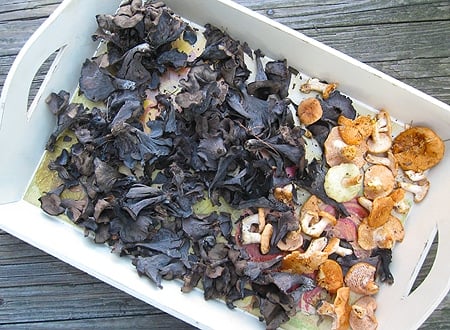
I was raised, like most Americans, with a healthy fear of mushrooms instilled in me by my mother. Mum knew her wild plants, and loved to take us berry picking, but mushrooms were off limits. This was probably a good thing, because while many mushrooms may look like candy — some are more colorful than any skittle or sweet tart — even the edible ones don’t taste like candy. Well, maybe the candy cap does, but that doesn’t live where I grew up in New Jersey. And eating a pretty little mushroom can lead to a quick end to a budding forager’s career…
I didn’t even know there were edible wild mushrooms until I was a teenager, when our class went on a nature walk in some nearby woods. The instructor showed us a freakish looking thing that looked like frozen lava flowing from a tree. A sulphur shelf, also known as chicken of the woods. I was entranced. From that moment on, I wanted to find and eat wild mushrooms, which I found exotic, mysterious and more than a little dangerous. After all, for every chicken of the woods, there is a destroying angel or Satan’s bolete.
But it was not until I was fully an adult that I gained the skills I needed to be a passable mushroomer, and it’s only been in the last decade that I have known enough to be able to show others. Never in a million years would I imagine that my family would follow me on this trip.
Then I got a note from my mum. She’d gone on a mushrooming walk on Cape Ann in Massachusetts, and on that walk the instructor showed her all sorts of mushrooms — just as mine had done so 25 years ago in the woods of New Jersey. She too had been bitten by the fungal bug, and it took only a week for her to come home with her first prize: A chicken of the woods mushroom, the same variety that had so entranced me many years ago.
That was just a couple days ago. I arrived in Gloucester Sunday night, and about 12 hours later we were in the forest looking for mushrooms. All of us. Mum, my sister Lizz, my brother-in-law Mark and their friend Hazie (yeah, that’s a nickname). It seems the fungal bug is contagious. Hazie, however, knows his mushrooms, and it was good to have some local expertise among us as we wandered around. Expectations were high because mum had said there was a good flush of mushrooms in the woods. She was right.
They were everywhere. Every few steps there was a russula, a lactaria, a suillus or an amanita. It was a fairytale landscape of lurid color and bizarre form. I’ve only seen a flush like this a few times in my life. Striking blue corts were everywhere, masquerading as edible blewits, but a look at the tell-tale cobweb on their gills betrayed them as toxic.
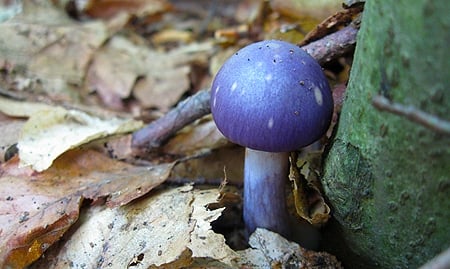
Dotted around were neon orange false chanterelles and pholiotas and canary-colored lactarias. I have no idea what this one is, although I think it is an amanita of some sort. It practically glowed in the gloom of the forest floor.

Hazie and I hung back as the rest of the crew walked ahead. We felt the Mushroom Force take hold of us, and we both felt compelled to walk off the trail into a wooded clearing. Hazie bent down to look at a mushroom. “Sweet tooth!” he said. I found another mushroom nearby. “Hedgehog!” I answered — the same mushroom, different common name. Dentinum repandum. I collect these mushrooms in the dead of winter in California. Here on Cape Ann their season is now. Go figure.

I love these mushrooms, which taste a little oyster-y and are more savory than a typical button mushroom. They are also unmistakable: Look at the icicles hanging down from underneath the cap. This is why this whole family of fungi are called the “toothed” mushrooms. Most are edible, and if you see one with white flesh and a buff-orange-tan-brown cap, you’re in business.
We saw another related mushroom, but let it be because it was too small. This would be the legendary lion’s mane, Hericium americanum. I’ve never eaten it, but it has a great reputation at the table. I can’t wait to go back to this shroom in a few days to harvest it when it’s a little larger. This one was maybe 7-8 inches across.
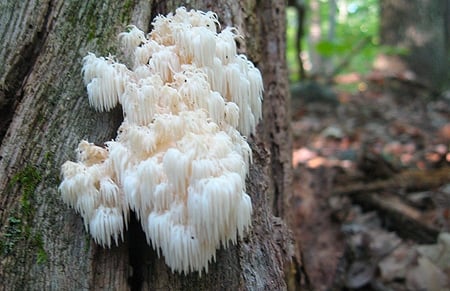
Another oddity I’ve never eaten is the coral fungus. There’s a lot of it around Gloucester now, in several varieties. The prettiest is this spindle-shaped yellow coral, which I only learned was edible later.
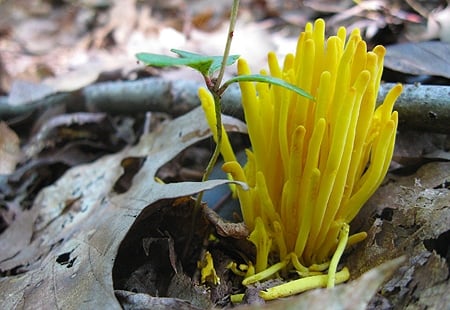
Far more common was the white coral mushroom, which we did collect. It is listed as edible, but I’ve never tried it. Anyone out there given it a go? Any tips on what to do with it? It sure is pretty, and it smells a little like the air on the seashore, briny and fresh.
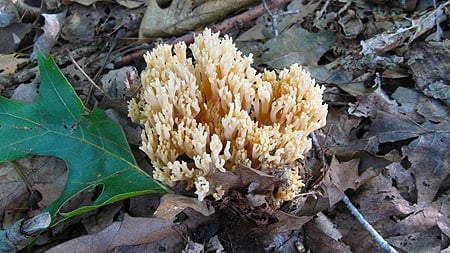
Other than the hedgehogs and the unknown edibility of these white corals, we also found tons of painted suillus, suillus spraguei. This is another edible of questionable worth. Some like it, others don’t. I’ll find out soon enough, as we collected several pounds. Anyone ever played with these?
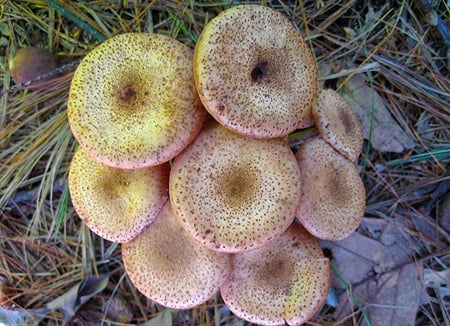
Just a few feet from the suillus, we found one of my favored edibles, the honey mushroom or armillaria mellea. I’ve written about honey mushrooms before, and I’ve found them to be pretty good — not fabulous, but well worth eating. Not everyone agrees with me, and with good reason: Honey mushrooms affect different people in different ways, and some people get stomach upset from them. Regardless, honeys need to be cooked well before eating. I make them into a pierogi filling.
Maybe I’ll make some more pierogi with them this time, or maybe I’ll just fry them up simply. I will be fascinated to see if anyone else in my family gets an upset stomach from them — is my tolerance of this mushroom genetic or does tolerance stem from each individual’s unique intestinal flora?
Finally, as we were walking back to the car, we found the prize of the day. They look like shadows, ghosts of summer’s golden chanterelles. The French call them the Horn of Death, not very charitable considering that this is one of the greatest edible mushrooms in the world. Meet craterellus cornucopioides, the black trumpet.
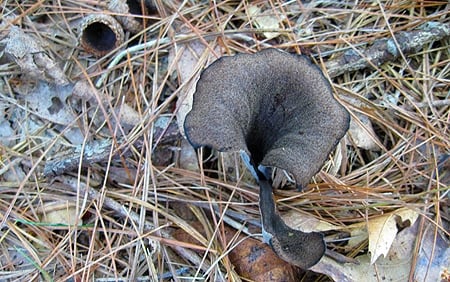
It’s been relatively hot here in Massachusetts, and this means many mushrooms have already dissolved into a black goo. As you might imagine, spotting a little black mushroom amidst the blackened corpses of other mushrooms isn’t easy. But once we got our eyes on, we found lots and lots of them. Look for the black hole in the center of a shadow, and you will probably have yourself a black trumpet.
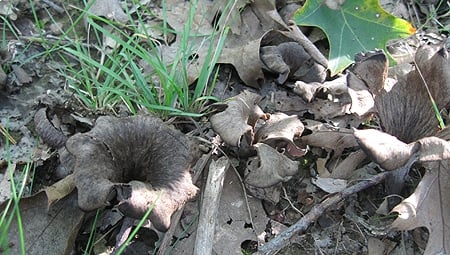
Curiously, just as we found black trumpets and hedgehogs in the same general area this week, the same holds true when I find black trumpets in winter in California. Even more curious, these mushrooms fruit around the same plant, more or less. In California, you look near huckleberries. In Massachusetts, look around blueberries — both members of the vaccinium clan. Hazie noted that there must be something about acidic soil, which all vaccinium species prefer.
I happen to have brought a big bag of dried black trumpets with me on this book tour I am on, so I plan on letting Lizz and Mark have our entire haul. As for mum and her chicken of the woods mushroom, I cooked it up for her in a little butter, Armagnac, chicken stock and cream. It was wonderful.




Ahh the rain has come again here in the West. We soon will have another reason to foray out to the hills again. What goodness will await? Perhaps in a month little piggies to go with our little piggy about to be harvested in 3 weeks. Yummo!
Great post Hank and glad to see your book tour in going well. Keep up the fun work.
Alan
Hank I will definitely be interested as will my husband. All the better that you are the one leading them! Thanks.
Neat you found all these, looks like Mass is about 3 weeks behind Maryland . East coast mushrooms are fickle compared to Sonoma County, CA (where I’m from). Growing seasons here seem to be just a few short weeks compared to the 4 month long chanterelle season we norcalers get. Been somewhat of a bumper crop this year for black chanterelles and goldens in MD. We found a pretty good haul of hedgehogs a few days ago and have maybe 50 lbs of maitakes to process. Interesing you found the repandums under blueberry, here they and craterellus seem to grow almost exclusively under beech trees. Looking forward to CA boleting in the next few weeks!
Hank, given the state of our social life, I definitely would have bet against our having conflicts for both the Providence and Boston dinners, but we did. We were very sorry not to be able to actually see the whites of your eyes.
Next time you visit family, and you’re not quite so busy with a book tour, there will be no excuse for not visitng the Cape …
Finally a post on New England mushrooms! Hen of the Woods are everywhere right now but I’ve yet to find those elusive Black Trumpets 🙁
Enjoyed your post, Hank. Here in Virginia (and from what I hear, it’s the same all along the East Coast), we’ve been having a bumper year for wild mushrooms; it pretty much started after Irene came through and dumped all that rain on us. In, the past month, I’ve collected honeys, two different chanterelles, parasols, hen-of-the-woods, comb tooth & bearded tooth, puffballs- and the list goes on. This coincides nicely with the start of our hunting season; I’ve been gathering mushrooms while squirrel hunting (I’m thinking a nice squirrel stew with mushrooms). Keep up the good work!
Will
Very nice article. I’m thinking I need to go look for these suckers pretty soon. It will be my first forage experience. I am wondering if any of you guys know good local/regional sources to forage around Lake County.
The mushroom photos are extremely beautiful.
Great pictures, I know you’ve enjoyed taking it while walking in the undergrowth. But be careful, if you want to eat a mushroom, make sure it’s safe to eat. There are some poisonous mushroom pupping our anywhere.
Nice job Hank! The black rice looks awesome.
I tried your Madrone Bark tea eggs, but substituted HOP’s for the Madrone.
They came out nice, but I had trouble getting the eggs to crack uniformly. Keep ’em coming. We love them shrooms.
Eric
This is a great post! And some of those mushrooms would be perfect for my mushroom soup recipe!
Jessica: Actually, I will be doing foraging walks in the Sacramento area this winter, and if you are interested I will let you know the details when they are set. There should be mushrooms around then.
Ellen: Do you like the painted suillus dried or fresh? I hear it gets slimy when cooked fresh…
Marie: What are the best ways to cook corals? Saute? Fresh? Dried? Boil?
Tamar: Keep looking, you’ll find some. Sad to have missed you here in Massachusetts, though. So close, yet so far….
I’m going to have to cast my vote against the painted suillus. They have that nice earthy mushroomy taste, but they cook up slimy, every time.
I’ve been looking for black trumpets ever since you wrote about them in your solstice meal, but I haven’t found any … yet.
Love the post! We eat coral mushrooms every year – they are common around here and sold in the markets during the rainy season. There is one inedible that does get mixed up in the bunches – it doesn’t kill but it does lead to an uncomfortable stomach. It tends to be a little bit pinker than the white corals.
We also get lobster mushrooms, chantrelles, and porcini. I’m working on making the list of the mushrooms we’ve IDed this year… it’s over a hundred and about half are edible.
This is a soup I made with corals a year ago – they really are lovely mushrooms and have a nice texture and taste. https://www.cookingforcommunity.com/recipes/changing-seasons-wild-mushroom-soup
I’m a fan of the painted suillus; it grows in the swamp across the lake along with the wild grapes and highbush blueberry. And just so you can judge my taste, I also love black trumpets, hedgehogs, and bears head tooth/lion’s mane. BTW, Gary (Lincoff) says the white coral tastes like rancid popcorn so even though I have lots in my mossy lawn, I’ve never tasted them. Please let us know if you try them.
Mushroom hunting in something I have always wanted to do, and have never had the courage. Definitely not something I will do without having someone who knows what they are doing to point the way. Do you know if there are any classes or guides here in Sacramento? Your midnight rice looks beautiful.
What a great post! And the photos of the mushrooms are beautiful! Thank you for the great information about various mushrooms too! Oh, and thank you again, for the recipe. I recently bought some black rice (Chinese Forbidden Rice), and I’ve been waiting to find a great recipe to try it out. The rice cooking hints are also good information. Totally great post!
I live in NJ near a wonderful state park (Hunterdon County) and I need to learn how to forage for mushrooms. One of my favorite dishes is a mushroom cobbler I make for Thanksgiving…but love, love, love mushrooms all year round. The rice looks wonderful. Now…a lesson on growing truffles in your home please! 😉
What gorgeous photos! I so enjoyed taking that walk through the woods with you vicariously.
Oh the black trumpet… this is the first year I’ve tried them and I’ve kicked myself for not trying them sooner. They have replaced the Lobster as my favorite mushroom. I have a jar of dried ones that I’m holding fast to, to bring some flavor to the long Minnesota winter that is (too) soon to arrive. I may have to try your rice recipe but with some of the local wild rice instead. (gotta use what you have sometimes) Thanks for your blog, it’s a constant inspiration.
I can’t wait to go mushroom hunting again! Unfortunately, there have been no mushrooms at all due to the drought here in Texas.